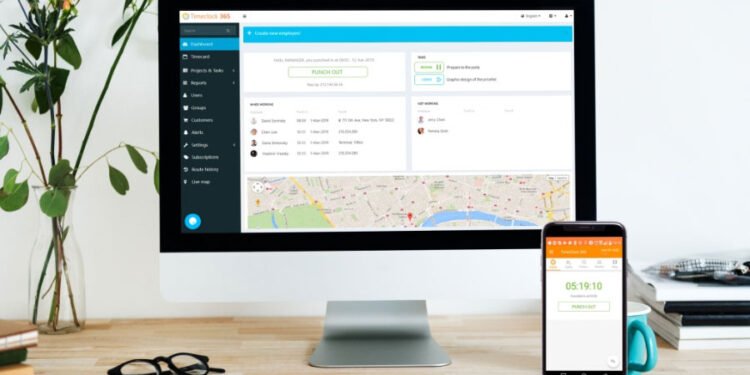Having a time and attendance system in your company is an excellent idea, and it can have a lot of benefits. When using this type of software, you can track employee hours, which can help you manage PTO and reduce your bottom line. Plus, with a mobile app, you can also better understand the hours worked by your whole workforce.
Mobile Apps Provide an Overview of Hours Worked by the Whole Workforce
Data collection is one of the most critical components of any mobile workforce management strategy. Fortunately, the internet makes it possible to connect with remote workers and keep tabs on employees and projects in the field. A secure mobile workforce management app is the ticket for companies that are more interested in letting their employees bring personal devices on the job. These apps can make tracking and measuring employee performance a snap.
The DOL-Timesheet App is one of today’s most impressive mobile workforce management tools. It allows employees to track their hours, pay rates, and breaks. In addition, it offers multiple pay frequency options to fit every company’s budget. It provides the requisite data and offers some exciting enhancements, such as a comment capability and the ability to add your comments.
Using the mobile workforce management app as a central hub for data entry is a smart move, as is updating your company’s mobile devices. Keeping your devices and apps up to date will ensure your data stays safe while keeping your customers happy. Similarly, integrating your employees’ mobile devices into your organization’s workflow makes your team more efficient, which means better customer service. This is especially true if you are a B2B customer with a field force.
Automated Time and Attendance Records
An automated time and attendance record system can benefit a business. It can help reduce the time and cost of payroll processing, improve workplace efficiency and security, and improve employee satisfaction.
The best time and attendance systems can also help with other tasks, such as scheduling employees and managing paid time off (PTO). They are available in the cloud or on-premises formats. Choosing one can be a complicated process.
Manual paper-based time and attendance tracking can be very tedious, particularly for smaller businesses. These systems are error-prone and expensive, and they can only sometimes produce accurate records.
Modern timekeeping eliminates potential distractions and helps workers focus on their jobs. Additionally, it can reduce overtime and ensure that your company stays compliant with legal rules.
Accurate time and attendance records can also help reduce the risk of payroll fraud. If you suspect someone is working more than the hours that they were scheduled to, you can use your data to identify them.
In addition to preventing payroll errors, an accurate time and attendance record can help you make more informed business decisions. For example, if you know that an employee spends more time on specific projects than they should, you can change their shifts. And if you have a team of salaried employees, you can implement time and attendance software to make their work more efficient.
Manage PTO
If you have a small to medium-sized organization, consider using a time and attendance system for your employee scheduling. These systems can help you automate and streamline payroll processing, including processing time off requests. Having the right software in place can be a great way to boost employee morale and productivity.
Ideally, you’ll find a time and attendance system that can integrate with PTO tracking, which allows you to easily automate the process of accruing leave time. The right PTO management software can also help you create more productive workplaces by enabling employees to focus on their work rather than the tedious tasks involved in managing time off.
Time and attendance systems can be valuable for hourly and salaried employees. They can help you track employee time off and accruals for vacation and sick time. Some offer cloud-based solutions, which eliminate the need for hardware.
Many systems also provide a self-service feature, which allows employees to make time-off requests directly from the system. Employees can use the system to check their balances, check the validity of their requests, and even submit suggestions.
Some systems can even be configured to automatically approve or reject a request based on criteria such as blackout periods, other coworkers’ vacation schedule conflicts, or PTO balances.
Reduce Bottom Line
The benefits of time and attendance systems include improving productivity, efficiency, and employee satisfaction. These systems can help you fine-tune your operating budget, prevent overscheduling, and improve your payroll process.
Time and attendance are crucial resources in organizations. Keeping track of how much time employees spend on the job is essential for preventing overtime payouts and theft. Inaccurate time tracking can lead to erroneous payroll calculations, negatively affecting the bottom line.
Time and attendance software has been around for a long time. But advances in technology and functionality have allowed companies to use these systems in new and more creative ways.
Automated time and attendance systems can reduce human error and ensure accurate data. They can also be used with other applications, such as a payroll system. This makes the process easier for managers and eliminates the need for manually entering data into the plan.
An automated system costs between $2 and $10 per employee. This includes the software, the hardware, and technical support. However, the cost savings can be significant.
Labor costs are one of the most significant expenses for an organization. Accurate time tracking can result in precise payroll calculations and compliance with regulatory requirements. Having the correct information at your fingertips can save you from costly regulatory compliance issues.


